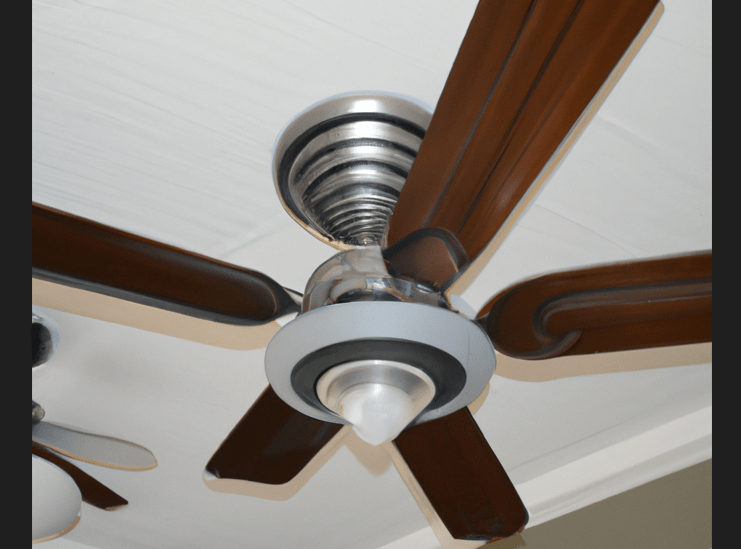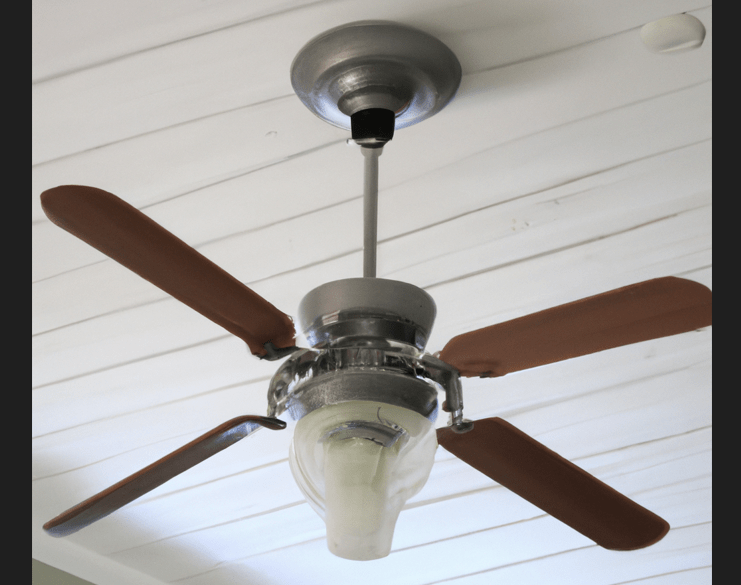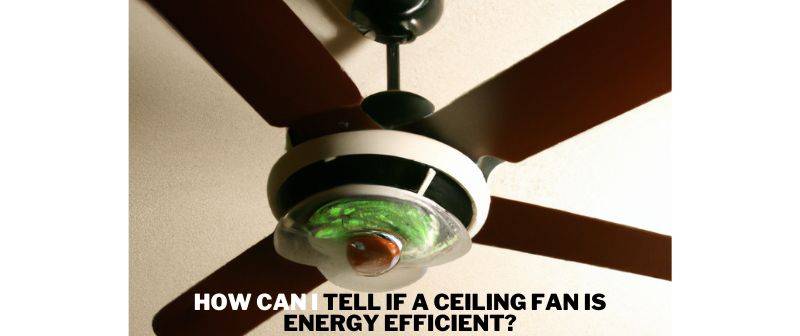As homeowners, we’re always looking for ways to save money on our energy bills and reduce our carbon footprint. One of the most effective ways to do this is by investing in energy-efficient appliances, including ceiling fans.
But with so many options on the market, how can you be sure that the fan you’re considering is truly energy efficient?
In this article, we’ll explore the key factors that contribute to a fan’s energy efficiency, and provide you with the tools you need to identify an energy-efficient ceiling fan.
From understanding the importance of Energy Star certification to deciphering the CFM/watt rating, we’ll take the guesswork out of selecting an energy-efficient fan that’s right for your home.
What Makes Ceiling Fan Energy Efficient?

When it comes to understanding what makes ceiling fan energy efficient, there are a few key factors to consider.
First and foremost, the size and design of the motor play a crucial role in determining a fan’s energy efficiency. A smaller, more energy-efficient motor will use less energy to operate, resulting in lower energy bills for you.
Additionally, the design of the motor can also impact energy efficiency. For example, a DC motor will typically be more energy efficient than an AC motor.
Another important factor to consider is the design and size of the blades. A fan with larger blades will generally move more air, but it will also use more energy to do so.
This is why it’s important to select a fan with the appropriate blade size for the room in which it will be installed.
Additionally, the design of the blades can also impact energy efficiency. For example, a fan with aerodynamic blades will typically be more energy efficient than a fan with traditional blades.
Finally, control options can also play a role in determining a fan’s energy efficiency. Fans with multiple speed settings and remote control options allow you to adjust the fan’s speed and settings as needed, which can help to optimize energy efficiency.
When it comes to Energy Star certification, it’s a government-backed program that helps to identify and promote energy-efficient products.
A fan with Energy Star certification has met strict energy efficiency guidelines set by the government and is verified to be one of the most energy-efficient fans on the market.
When considering an energy-efficient fan, it’s always a good idea to look for the Energy Star label, so you can have peace of mind that you’re making a smart investment.
How to Identify an Energy-Efficient Ceiling Fan

When it comes to identifying an energy-efficient ceiling fan, the first thing you should look for is Energy Star certification. This certification is awarded by the United States Environmental Protection Agency (EPA) to products that meet strict energy efficiency guidelines.
By choosing a fan with Energy Star certification, you can be confident that it meets the highest standards of energy efficiency.
Another important piece of information to look for when identifying an energy-efficient ceiling fan is the CFM/watt rating.
This rating tells you how many cubic feet of air the fan can move per watt of energy it uses. The higher the CFM/watt rating, the more efficient the fan is. When comparing different fans, be sure to compare the CFM/watt ratings to see which one is the most energy efficient.
Additionally, you should also consider the motor size and design of the fan when identifying an energy-efficient ceiling fan.
A fan with a smaller motor will use less energy and be more energy efficient than one with a larger motor. Look for fans with DC motors; they are more energy-efficient than traditional AC motors.
By taking into account these three key factors, you can make an informed decision when choosing an energy-efficient ceiling fan.
Not only can an energy-efficient fan help you save money on your energy bills, but it can also reduce your environmental impact and help create a more comfortable living space.
Other Considerations
When it comes to selecting an energy-efficient ceiling fan, it’s important to consider not just the fan’s energy efficiency ratings, but also other factors that can impact its performance and efficiency.
For example, the size and layout of the room in which the fan will be installed can play a big role in determining the appropriate size and style of the fan for the space. A larger room, for example, may require a larger fan with more blades to circulate air effectively.
Similarly, a room with high ceilings may require a fan with a longer down rod to ensure optimal airflow.
The climate and usage patterns of the space can also impact the efficiency of a fan. For example, in a warmer climate, a fan with a higher CFM/watt rating may be needed to circulate more air and keep the room cooler.
On the other hand, in a cooler climate, a fan with a lower CFM/watt rating may be sufficient. Additionally, how frequently the fan will be in use and how long it will be run each day should be considered.
Finally, the style and design of the fan can also play a role in its energy efficiency. A fan with a sleek, aerodynamic design, for example, maybe more energy efficient than one with more ornate, decorative blades.
Additionally, some fans are designed to complement specific interior decorating styles, which can be a nice feature for many homeowners.
In addition to these factors, it’s also important to consider the control options available on the fan, such as a remote control or wall control, as well as the fan’s speed settings, timer function, and reverse function.
These features can help you optimize the energy efficiency of the fan by adjusting the settings to match your specific needs and usage patterns.
Conclusion
In conclusion, energy efficiency is an important consideration when selecting a ceiling fan for your home.
By understanding the key factors that contribute to a fan’s energy efficiency, such as motor size and design, blade design and size, and control options, you can make an informed decision when choosing a fan.
Additionally, it’s important to consider other factors, such as the room size and layout, climate and usage patterns, and style and design of the fan, in order to ensure that the fan you choose is the best fit for your home and usage needs.
Finally, by making use of a fan’s control options, you can optimize the energy efficiency of the fan and ensure that it is running at its most efficient settings.
With the knowledge and information provided in this article, you will be well-equipped to select an energy-efficient ceiling fan that will save you money on your energy bills and help reduce your carbon footprint.
FAQs
How can I tell if a ceiling fan is energy efficient?
Determining whether a ceiling fan is energy efficient can be a bit tricky, but with the right information and tools, it’s definitely doable. One of the most important things to consider is the fan’s Energy Star certification.
Energy Star is a government-backed program that helps consumers identify products that meet certain energy efficiency standards.
Ceiling fans that have earned the Energy Star label have been independently certified by a third-party testing organization to meet or exceed specific energy efficiency criteria. This is a great place to start when looking for an energy-efficient fan.
Another important factor to consider is the fan’s CFM/watt rating. CFM stands for cubic feet per minute, and it’s a measure of how much air a fan can move.
The watt rating, on the other hand, is a measure of how much energy the fan uses. The CFM/watt rating is a ratio of these two values, and it’s a good way to compare the energy efficiency of different fans.
Generally speaking, a fan with a higher CFM/watt rating is more energy efficient than one with a lower rating.
looking for an energy-efficient
When you are looking for an energy-efficient ceiling fan, also make sure to check for the fan’s control options, such as a remote control or wall control, as well as the fan’s speed settings, timer function, and reverse function.
These features can help you optimize the energy efficiency of the fan by adjusting the settings to match your specific needs and usage patterns.
Lastly, it is important to consider the room size and layout, climate and usage patterns, and style and design of the fan, in order to ensure that the fan you choose is the best fit for your home and usage needs.
With all this information in mind, you will be able to find a fan that is energy efficient and perfect for your home.
How can I compare the energy efficiency of different ceiling fans?
When comparing the energy efficiency of different ceiling fans, there are a few key factors to consider. One of the most critical factors is the fan’s airflow rating, measured in cubic feet per minute (CFM).
The higher the CFM, the more powerful the fan is, and the more efficiently it can circulate air in a room. However, it’s imperative to note that a fan with a high CFM rating may also consume more energy.
Another key factor to consider is the fan’s speed settings. Ceiling fans with multiple speed settings allow you to adjust the fan’s performance to your needs, which can help conserve energy.
Additionally, some fans come with energy-saving modes that automatically adjust the fan’s speed based on the temperature and humidity levels in the room, which can also help conserve energy.
Another factor to consider is the fan’s motor efficiency. Look for fans with a high motor efficiency rating, measured in cubic feet per minute per watt (CFM/W). The higher the CFM/W rating, the more efficient the fan’s motor is, and the less energy it will consume.
Lastly, it’s imperative to consider the fan’s overall design and construction. Look for fans made with high-quality materials that are designed to last, as well as fans with a sleek and modern design that can complement any home decor.
Comparing the energy efficiency of different ceiling fans can be a complex task. However, by considering factors such as airflow rating, speed settings, motor efficiency, and overall design, one can make a more informed decision about which fan to choose.
Additionally, the Energy Star rating can be used as a reference point to compare the energy efficiency of different ceiling fans.
Can a ceiling fan’s style and design impact its energy efficiency?
When it comes to selecting a ceiling fan, style and design may be important factors for many homeowners.
However, it is important to note that the style and design of a ceiling fan do not directly impact its energy efficiency.
While a sleek and modern design may be visually appealing, it does not necessarily mean that the fan will be more energy efficient than one with a more traditional design.
What truly matters is the technology and components used in the fan, such as the motor and blade design. An Energy Star-rated fan, for example, will have a higher level of energy efficiency regardless of its design.
It is important to not just focus on the aesthetics of the fan, but also consider the energy efficiency and performance of the fan.
- 25 Neutral Boho Bedroom Inspiration Cozy, Calm & Beautiful - July 12, 2025
- 26 Backyard Shower Ideas That Turn Your Outdoor Space Into a Spa - July 11, 2025
- 26 Breathtaking Farmhouse Kitchen Designs to Inspire Your Remodel - July 10, 2025

